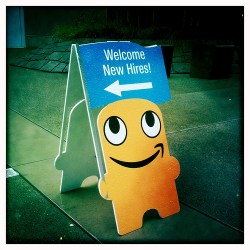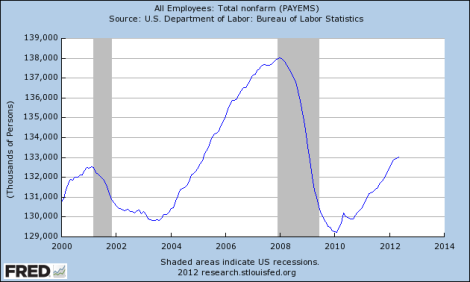
Photo by Will Merydith.
This morning, as it does on the first Friday of every month, the Bureau of Labor Statistics (BLS) released its Employment Situation Summary. The “non-farm payroll” numbers, as they’re better known, estimate the number of jobs created during the prior month, broken down by sector and participant demographics.
Economic reporters predicted that today’s report would be somewhere on the order of 100,000 new jobs. It wasn’t. The BLS estimates that 80,000 new jobs were created in June, keeping the unemployment rate steady at 8.2 percent. Here’s how the data breaks down.
- 12.7 million people are currently unemployed. The number of long-term unemployed (those who’ve been out of work for 27 weeks or more) stayed consistent at 5.4 million, about 42 percent of the unemployed.
- Over the second quarter of 2012, job growth averaged 75,000 a month, compared to 226,000 in the first quarter.
- 84,000 new jobs were created in the private sector, and the public sector (government) lost 4,000 jobs. This continues a recent trend of public-sector contraction. Over 600,000 public-sector jobs have been lost in the past few years.
- The unemployment rate for blacks went up 0.8 percent to 14.4 percent overall. This is consistently the highest rate of unemployment for any demographic group. Most other groups remained consistent in June.
- The rate of participation — people of working age who are employed/seeking employment — didn’t change.
- Manufacturing jobs went up by 11,000. Professional and business services increased by 47,000 jobs. Health care went up 13,000. Mining and logging jobs remained unchanged; oil and gas extraction went up slightly.
- Average hourly earnings have increased 2 percent over the course of the year. Average hours worked ticked up 0.1 hour.
Politically speaking, this is much better news for Camp Romney than the president. For the unemployment rate to drop below 8 percent by November, the economy would need to grow by 219,000 jobs a month.
The topline number will undoubtedly change in next month’s report. The original estimates for May (released at the beginning of June) indicated that 69,000 total jobs were created. Today, that was revised to 77,000. April was revised downward from 77,000 to 68,000. In other words, today’s announcement is a net gain of 79,000 jobs, including revisions.
For good analysis of today’s numbers, see Slate’s Matt Yglesias, Business Insider’s Joe Weisenthal, and the Washington Post’s Ezra Klein.
The BLS doesn’t track green jobs as part of its monthly numbers, but does regularly measure two aspects of the green economy: green goods and services (estimated at some 3.1 million jobs in 2010) and green technologies and practices (854,700 jobs in August 2011).
Update: Business Insider notes that 100,000 local teaching jobs have been eliminated in the past year.
Update: Here’s a graph comparing overall, public-, and private-sector employment since January 2009.






